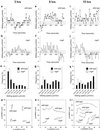Pattern formation by a cell surface-associated morphogen in Myxococcus xanthus
- PMID: 11842199
- PMCID: PMC122314
- DOI: 10.1073/pnas.042535699
Pattern formation by a cell surface-associated morphogen in Myxococcus xanthus
Abstract
In response to starvation, an unstructured population of identical Myxococcus xanthus cells rearranges into an asymmetric, stable pattern of multicellular fruiting bodies. Central to this pattern formation process are changes in organized cell movements from swarming to aggregation. Aggregation is induced by the cell surface-associated C-signal. To understand how aggregation is accomplished, we have analyzed how C-signal modulates cell behavior. We show that C-signal induces a motility response that includes increases in transient gliding speeds and in the duration of gliding intervals and decreases in stop and reversal frequencies. This response results in a switch in cell behavior from an oscillatory to a unidirectional type of behavior in which the net-distance traveled by a cell per minute is increased. We propose that the C-signal-dependent regulation of the reversal frequency is essential for aggregation and that the remaining C-signal-dependent changes in motility parameters contribute to aggregation by increasing the net-distance traveled by starving cells per minute. In our model for symmetry-breaking and aggregation, C-signal transmission is a local event involving direct contacts between cells that results in a global organization of cells. This pattern formation mechanism does not require a diffusible substance or other actions at a distance. Rather it depends on contact-induced changes in motility behavior to direct cells appropriately
Figures

References
Publication types
MeSH terms
Substances
LinkOut - more resources
Full Text Sources

